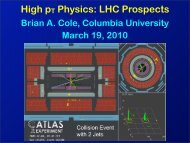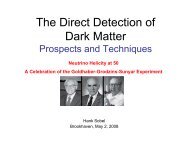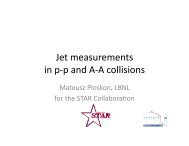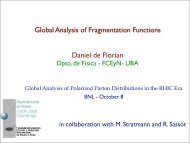One flavor QCD Abstract - BNL theory groups - Brookhaven National ...
One flavor QCD Abstract - BNL theory groups - Brookhaven National ...
One flavor QCD Abstract - BNL theory groups - Brookhaven National ...
Create successful ePaper yourself
Turn your PDF publications into a flip-book with our unique Google optimized e-Paper software.
Consider describing this model by an effective potential for the η ′ field. This should include the<br />
possibility for these particles to self interact, suggesting something like<br />
V(η ′ ) = m q + c<br />
η ′ 2 + λη<br />
′4 . (8)<br />
2<br />
To get the phase diagram of Fig. (1), we add in a m 5 term as a linear piece in the eta prime field<br />
V(η ′ ;m 1 ,m 5 ) = m 1 + c<br />
η ′ 2 + λη<br />
′4 + m5 η ′ . (9)<br />
2<br />
At m 1 < −c the effective mass of the eta prime goes negative. This will give a spontaneous<br />
breaking in the canonical manner, with the field acquiring an expectation value<br />
√<br />
〈η ′ |m1 | − c<br />
〉 ∼ 〈ψγ 5 ψ〉 ∼ ≠ 0. (10)<br />
4λ<br />
As this is a CP odd field, CP is spontaneously broken. In particular, vertices connecting odd<br />
numbers of physical mesons will not vanish, unlike in the unbroken <strong>theory</strong> where the number of<br />
pseudoscalar mesons is preserved modulo 2.<br />
Note that this transition occurs at a negative quark mass, and nothing special happens at m 1 = 0.<br />
Of course the bare quark mass is not really physical since it is a divergent quantity in need of renormalization.<br />
Normally in the multiple <strong>flavor</strong> <strong>theory</strong> chiral symmetry forces this renormalization to<br />
be multiplicative, making vanishing mass special. However with only one <strong>flavor</strong> there is no chiral<br />
symmetry; thus, there is nothing to prevent an additive shift in this parameter. We will see later<br />
how such a shift is generated non-perturbatively by topologically non-trivial gauge configurations.<br />
Despite this, with a cutoff in place, these qualitative arguments suggest it is only for a negative<br />
quark mass that this parity violating phase transition will take place. And this also suggests that<br />
the magnitude of this gap is of order the square of the eta prime mass. As the latter is of order the<br />
strong interaction scale, the critical mass for the CP violating transition is of order Λ qcd , as it must<br />
be.<br />
This argument is suggestive but certainly not rigorous. To lend more credence to this qualitative<br />
picture, note that a similar phenomenon occurs in two dimensional electrodynamics. The<br />
Schwinger model is exactly solvable at zero bare mass, with the spectrum being a free massive<br />
boson. However, for negative bare mass, qualitative semi-classical arguments indicate the same<br />
structure as discussed above, with a spontaneous generation of a parity violating background electric<br />
field. Under the bosonization process [11, 12], the quark mass term corresponds to a sinusoidal<br />
term in the effective potential for the scalar field<br />
mψψ ↔ ξ mcos(2 √ πη ′ ) (11)<br />
6






